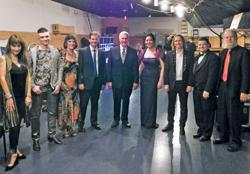
Two special programs in the February schedule for American Public Media’s Pipedreams show will highlight two of the foremost modern concert-hall organs in the United States, at the Walt Disney Concert Hall in Los Angeles and the Kimmel Center in Philadelphia.
Program #1506 (in distribution beginning 2/9/15) will highlight the 10th anniversary sold-out concert for “Hurricane Mama,” the Glatter-Götz/Rosales pipe organ at Disney Hall, with its iconic Frank Gehry-designed façade, recorded on November 23, 2014. Shown in the photo are organists Carol Williams, Cameron Carpenter, Cherry Rhodes, Ken Cowan, Frederick Swann (who played the official inaugural concert on the instrument in 2004), Chelsea Chen, Christoph Bull, Aaron David Miller, Michael Barone, and Pipedreams host/producer Michael Barone. Works played were by Bach, Searle Wright, Robert Hebble, Dezsö d’Antalffy-Zsiross, Clarence Mader, Maurice Ravel, plus Williams, Miller, and Carpenter.
Program #1508 (in distribution beginning 2/23/15) is devoted to works by Marcel Dupré and Sergei Rachmaninoff. Along with Dupré’s Opus 36 set of three preludes and fugues, soloist Jeremy Filsell will play his organ arrangement of Rachmaninoff’s Symphonic Dances, Opus 45, and collaborate with Wanamaker organist Peter Richard Conte in Rachmaninoff’s Piano Concerto No. 1, Opus 1. The Dupré and some of the Rachmaninoff selections were performed on the Fred J. Cooper Memorial Organ (by Dobson Pipe Organ Builders) in the Kimmel Center’s Verizon Hall, and the concerto on the Wanamaker Organ in nearby Macy’s department store.
Other February programs feature the music and commentary of American composer Gerald Near (#1505; 2/2/15) and finalists from the Miami International Organ Competition (#1507; 2/16/15). Pipedreams, distributed by American Public Media, is aired weekly at various times on ca. 130 classical-music/public-radio stations. For information and online program access: www.pipedreams.org.

